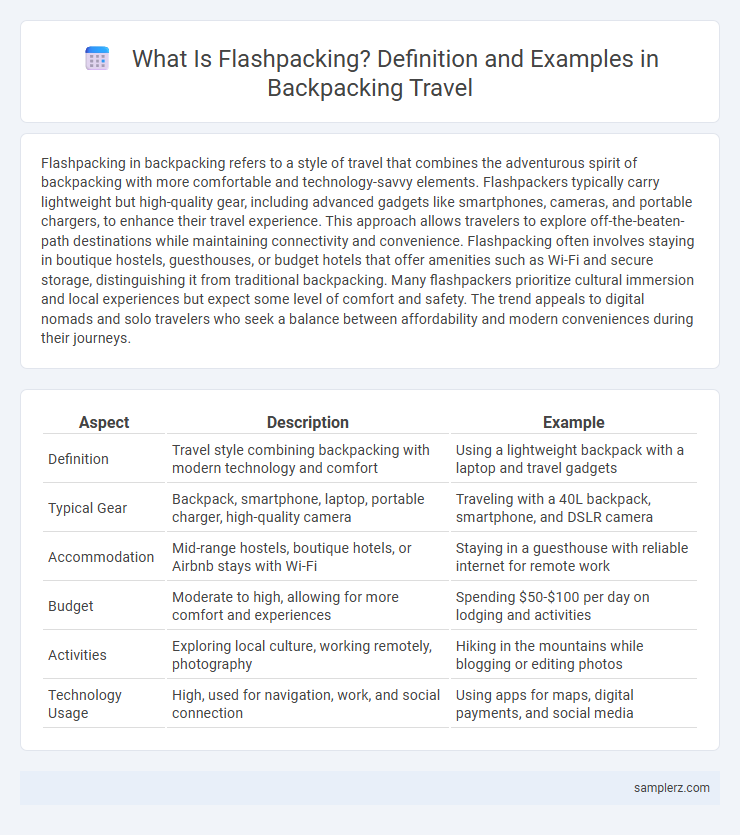Flashpacking in backpacking refers to a style of travel that combines the adventurous spirit of backpacking with more comfortable and technology-savvy elements. Flashpackers typically carry lightweight but high-quality gear, including advanced gadgets like smartphones, cameras, and portable chargers, to enhance their travel experience. This approach allows travelers to explore off-the-beaten-path destinations while maintaining connectivity and convenience. Flashpacking often involves staying in boutique hostels, guesthouses, or budget hotels that offer amenities such as Wi-Fi and secure storage, distinguishing it from traditional backpacking. Many flashpackers prioritize cultural immersion and local experiences but expect some level of comfort and safety. The trend appeals to digital nomads and solo travelers who seek a balance between affordability and modern conveniences during their journeys.
Table of Comparison
| Aspect | Description | Example |
|---|---|---|
| Definition | Travel style combining backpacking with modern technology and comfort | Using a lightweight backpack with a laptop and travel gadgets |
| Typical Gear | Backpack, smartphone, laptop, portable charger, high-quality camera | Traveling with a 40L backpack, smartphone, and DSLR camera |
| Accommodation | Mid-range hostels, boutique hotels, or Airbnb stays with Wi-Fi | Staying in a guesthouse with reliable internet for remote work |
| Budget | Moderate to high, allowing for more comfort and experiences | Spending $50-$100 per day on lodging and activities |
| Activities | Exploring local culture, working remotely, photography | Hiking in the mountains while blogging or editing photos |
| Technology Usage | High, used for navigation, work, and social connection | Using apps for maps, digital payments, and social media |
Definition of Flashpacking in Modern Backpacking
Flashpacking redefines modern backpacking by blending the adventure of traditional low-budget travel with the convenience of technology and premium gear. It involves carrying high-quality, lightweight equipment and staying in boutique hostels or stylish accommodations while exploring remote destinations. This travel style targets digital nomads and young professionals seeking immersive experiences without sacrificing comfort or connectivity.
Key Differences Between Flashpacking and Traditional Backpacking
Flashpacking enhances traditional backpacking by incorporating lightweight technology such as portable chargers, GPS devices, and high-quality cameras for better connectivity and documentation. Unlike traditional backpacking's focus on minimalism and budget travel, flashpacking embraces comfort with mid-range accommodations and dining options while still maintaining an adventurous spirit. This hybrid approach appeals to travelers seeking both exploration and modern convenience during their journeys.
Essential Gear for the Flashpacker
Essential gear for the flashpacker includes a lightweight, high-capacity backpack designed for both comfort and durability on extended trips. High-tech gadgets like a compact laptop, portable charger, and noise-canceling headphones enhance productivity and entertainment while on the move. Quality travel clothing, versatile footwear, and a reliable travel insurance plan ensure convenience and safety throughout the backpacking adventure.
Popular Destinations for Flashpackers
Popular destinations for flashpackers include Bali, known for its blend of affordable luxury accommodations and vibrant digital nomad communities. Chiang Mai in Thailand offers a perfect mix of cultural experiences, coworking spaces, and budget-friendly living, attracting tech-savvy travelers. Lisbon, Portugal, stands out with its thriving startup scene, scenic beaches, and high-quality yet reasonably priced amenities ideal for flashpacking adventures.
Technology Use Among Flashpackers
Flashpackers integrate advanced technology such as high-speed portable Wi-Fi devices, GPS-enabled smartphones, and lightweight laptops to enhance their backpacking experiences. Utilizing apps for real-time travel updates, accommodation booking, and language translation streamlines their trips while maintaining connectivity. This tech-savvy approach distinguishes flashpacking by balancing adventure with efficiency and convenience.
Budget Strategies for Flashpacking Trips
Flashpacking combines the freedom of backpacking with upscale experiences, making smart budget strategies essential for maintaining balance. Choosing affordable yet comfortable accommodations like boutique hostels, using travel apps for exclusive discounts on transport and activities, and prioritizing local dining over tourist spots help maximize value without sacrificing comfort. Careful planning of high-cost items such as flights and gear rental enables flashpackers to enjoy extended travel without overspending.
Accommodations Preferred by Flashpackers
Flashpackers often prefer high-quality accommodations such as boutique hostels, affordable boutique hotels, and serviced apartments that offer both comfort and connectivity. These lodging options typically provide reliable Wi-Fi, private rooms, and workspaces, catering to digital nomads and remote workers who blend travel with productivity. Popular flashpacker destinations include cities like Bangkok, Bali, and Lisbon, where upscale yet affordable accommodations meet the needs of tech-savvy travelers.
Social and Cultural Experiences in Flashpacking
Flashpacking combines budget-friendly backpacking with enhanced comfort, allowing travelers to engage deeply with local cultures through authentic social interactions and participation in community events. Staying in boutique hostels or locally-owned guesthouses fosters meaningful connections with both fellow travelers and residents, enriching cultural understanding and creating lasting memories. Immersive experiences, such as attending traditional festivals or cooking classes, highlight the social dimensions that distinguish flashpacking from conventional backpacking.
Safety Tips for Flashpackers on the Road
Flashpacking combines budget backpacking with modern technology, requiring heightened safety measures to protect valuable gadgets. Using secure, slash-proof backpacks, employing RFID-blocking wallets, and staying connected with trusted travel apps enhance security while navigating unfamiliar locations. Prioritizing well-reviewed accommodations and sharing itineraries with family or friends ensures rapid response in emergencies and peace of mind on the road.
Inspiring Flashpacking Itineraries and Real-Life Examples
Flashpacking combines the adventurous spirit of backpacking with the comfort of modern technology and mid-range accommodations, ideal for travelers seeking both exploration and convenience. Inspiring flashpacking itineraries include a 14-day Southeast Asia route covering Bangkok, Chiang Mai, and Luang Prabang, highlighting cultural experiences alongside boutique hostels and coworking spaces. Real-life examples feature digital nomads who balance remote work with trekking the Inca Trail in Peru, showcasing how flashpacking integrates productivity and adventure seamlessly.

example of flashpacking in backpacking Infographic
 samplerz.com
samplerz.com